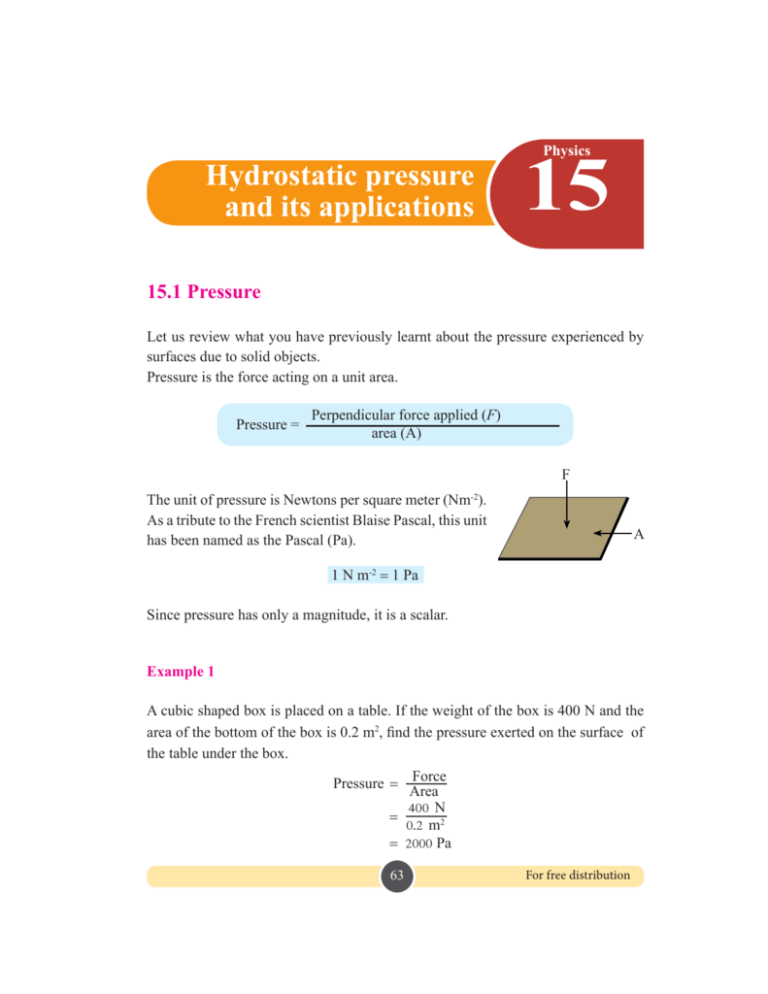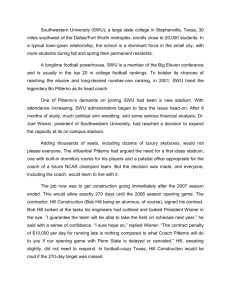Hydrostatic pressure and its applications - e
advertisement

Physics Hydrostatic pressure and its applications 15 15.1 Pressure Let us review what you have previously learnt about the pressure experienced by surfaces due to solid objects. Pressure is the force acting on a unit area. Pressure = Perpendicular force applied (F) area (A) F The unit of pressure is Newtons per square meter (Nm-2). As a tribute to the French scientist Blaise Pascal, this unit has been named as the Pascal (Pa). 1 N m-2 A 1 Pa Since pressure has only a magnitude, it is a scalar. Example 1 A cubic shaped box is placed on a table. If the weight of the box is 400 N and the area of the bottom of the box is 0.2 m2¿QGWKHSUHVVXUHH[HUWHGRQWKHVXUIDFHRI the table under the box. Force Area 400 N 0'2 m2 2000 Pa Pressure 63 For free distribution Example 2 The pressure exerted by a pile of soil distributed over an area of 8 m2 of the ground is 150 Pa. What is the force exerted on the ground due to the pile of soil? Force Area Pressure Force Pressure u area 150 N m2 u 8 m2 1200 N 15.2 Hydrostatic pressure Pressure is exerted not only by solids, liquids also exert pressure. When we place a solid object on a table, a pressure is exerted on the table because the force acting on the table due to the weight of the object spreads over the total contact area between the object and the table. Similarly, a pressure is exerted on the bottom of a container because, the force acting on the bottom of the container due to the weight of the liquid spreads over the bottom surface of the container. The pressure is exerted by the liquid not only on the bottom of the vessel. The vertical walls of the vessel will also experience the pressure. Apart from this, there are many more characteristics of pressure due to liquids (hydrostatic pressure). Let us investigate these characteristics of hydrostatic pressure. If you make some holes in a polythene bag, ¿OOLWZLWKZDWHUDQGKROGLWDVVKRZQLQ)LJXUH 15.1, what would you observe? You will observe that water exits through all the holes. Each of these holes exist at a different side of the bag. Water exits from through every hole because water pressure exists at the position Figure 15.1 – Polythene bag with holes of every hole. From this experiment you will ¿OOHGZLWKZDWHU observe that the water pressure acts in every direction. 64 For free distribution Take a plastic bottle with a height of about 25 cm, make several holes at WKHVDPHOHYHOQHDUWKHERWWRPDQG¿OO it with water. You will see water exiting the bottle as shown in Figure 15.2. You will notice that the horizontal distance traveled by water coming out of every hole is the same. This is because the pressure at the same level of a liquid is the same. Figure 15.2 – Set-up for comparing the hydrostatic pressure at the same level Figure 15.3 - Variation of the pressure with the height of the liquid column 1RZ OHW XV ¿QG RXW KRZ WKH KHLJKW RI WKH water column in a vessel affects the pressure. Make a set of approximately equally spaced holes from top to bottom of a plastic bottle ZLWKDKHLJKWRIDERXWFPDQG¿OOLWZLWK water. Hold the bottle at some height from the ground level as shown in Figure 15.3 and observe how the streams of water leave the bottle. You will observe that the speed of the streams of water coming from lower holes is greater than the speed of water coming from upper holes. Water exiting a hole has a higher speed when the pressure near that hole is higher. Therefore, it can be concluded that the pressure in a liquid increases with the depth of the liquid. /HW XV HQJDJH LQ$FWLYLW\ LQ RUGHU WR ¿QG RXW KRZ WKH SUHVVXUH RI D OLTXLG depends on the shape of the liquid column. 65 For free distribution Activity 15.1 Dependence of liquid pressure on the shape of the water column )LQG ¿YH WUDQVSDUHQW WXEHV having various shapes as shown by a, b, c, d and e in Figure 15.4. Fix them to a PVC tube with closed ends as VKRZQ DQG ¿OO WKH V\VWHP with water. Record the vertical heights of the water columns in each tube. Tube a b c d e a b c d e Tubes of various shapes PVC tubes Figure 15.4 - Investigating the dependence of the shape of the water column on the liquid pressure Vertical height of water column (cm) You will notice that the height of the liquid column of each of the tubes is the same. It is clear from the above experiments that the pressure at the equal levels of a liquid LVWKHVDPH7KHUHIRUHWKHSUHVVXUHDWWKHSODFHVZKHUHDOOWKHWXEHVDUH¿[HGWRWKH PVC tube is also equal. The height of the liquid column of each of the tube is being the same, we can conclude that the pressure due to a liquid column depends only on the height of the liquid column and not on the amount of liquid or the shape of the liquid column. According to our studies so far on pressure due to a liquid, the liquid pressure has the following characteristics. (i) The pressure at a certain point in a liquid depends on the height of the liquid column above that point. Pressure increases with the height of the liquid column. (ii) The pressure at the same level of a liquid is the same. (iii) At a given point in a liquid, the pressure is the same in all directions. (iv) Liquid pressure depends on the vertical height of the liquid column. It does not depend on the shape of the liquid column. 66 For free distribution If the height of the liquid column is h and the density of the liquid is ȡ, the weight of the liquid column above a unit area of the bottom surface of the container is KȡJ. Since this weight spreads over a unit area, the liquid pressure at the bottom is KȡJ. This result is true not only for the pressure at the bottom but for any other depth of a container. If there is a liquid column of height h above any point in a liquid as shown in Figure 15.5, then the liquid pressure P at that point is given by, P KȡJ h When the unit of h is meters (m), the unit of ȡ is kg m-3 and the unit of J is m s-2, the unit of pressure (P) exerted by the liquid column is N m-2. As mentioned before, the commonly used unit of pressure, the 3DVFDO3DLVGH¿QHGDV1P-2. ȡ Figure 15.5 - Pressure at a point situated at a depth h in a liquid Example 1 At a certain location, the depth of a certain point in a lake is 1.5 m. Find the pressure exerted by the water at the bottom of the lake at this location. (Density of water = 1000 kg m-3, J= 10 m s-2) Pressure = KȡJ 1.5 m u 1000 kg m-3 u 10 m s-2 15 000 Pa Example 2 The depth of a certain region of the sea is 10 m. Find the pressure exerted at this region by the sea water. (Density of sea water = 1050 kg m-3, J = 10 m s-2). Pressure = KȡJ 10 m u 1050 kg m-3 u 10 m s-2 105 000 Pa 67 For free distribution 15.3 Transmission of pressure through liquids Liquids do not get compressed by forces exerted on them. Therefore, the pressure exerted at one point in a liquid can be transmitted to another point in the liquid. A machine constructed to operate based on this principle is known as hydraulic press. Figure 15.6 illustrates the working principle of a hydraulic press 20 N piston A piston B 200 cm2 10 cm2 400 N Figure 15.6 - Hydraulic press It consists of a liquid volume trapped by two pistons A and B on either side of a cylindrical liquid columns. Assume that the area of piston A is 10 cm2 and the area of piston B is 200 cm2. If a force of 20 N is applied on piston A, the pressure it exerts on the liquid, 20 N P F 3 10 m2 A ×104 N m-2 N m2 2 N cm2 This pressure is transmitted to piston B through the liquid. Therefore, pressure at piston B is also 2 N cm-27KDWLVWKHÀXLGH[HUWVDIRUFHRI1YHUWLFDOO\XSZDUGV on each 1 cm2 of piston B. Therefore the total force exerted on the total area of 200 cm2 of piston B is 400 N (2 x 200). It is possible to transmit a force of 400 N to the larger piston from a total force of 20 N acting on the smaller piston because it is possible to transmit pressure through the liquid. (Since the forces acting on the pistons of liquid pressure machines are very high compared to the force due to the weight of the liquid column, the force exerted by the liquid column is not considered in calculations). 68 For free distribution Hoists used to lift vehicles in motor vehicle maintenance stations and service stations as the one shown in Figure 15.7, is a machine constructed to operate based on the principle of pressure transmission. force (smaller) large piston small piston distance moved distance moved force (greater) liquid Figure 15.7 - A hoist used to lift vehicles The hoist is constructed in such a way that the pressure generated in the oil through the small force applied on the large piston is transmitted to the large piston through the oil, transmitting a force equal to the weight of the vehicle placed on the large piston. This force lifts the vehicle. A jack is used to lift one side of a vehicle when a wheel of the vehicle needs to be detached. Out of the many types of jacks available, the type that is most frequently XVHGLVWKHK\GUDXOLFMDFNVXFKDMDFNVKRZQLQWKH¿JXUH7KHK\GUDXOLFMDFN also operates on the principle of pressure transmission. Here also a force is applied on a small piston. The pressure caused in the oil by this force is transmitted to the large piston through the oil, lifting one side of the vehicle. 69 For free distribution Figure 15.8 – Hydraulic jack Another instance where the principle of liquid pressure transmission is applied is WKHEUHDNV\VWHPLQYHKLFOHV,WVSULQFLSOHLVVKRZQLQ¿JXUH Master cylinder slave cylinder Figure 15.9 – Vehicle break system In the break system of a vehicle, when the driver applies a force on the break-pedal, it is transmitted to the piston in the master cylinder. This force exerts a pressure on the oil inside the cylinder. This pressure is then transmitted through the oil to the slave cylinder near the wheel. Then the brake-pads connected to the slave cylinder are pressed to apply a pressure on the break-discs or break-drums. Since the cross-sectional area of the slave cylinder is larger than that of the master cylinder, the force applied on the break-pads by the slave cylinder is greater than the force applied by the driver on the break-pedal. 70 For free distribution Exercise 15.1 (1) The pressure exerted at the bottom of a container due to a liquid inside it is 1500 Pa. What is meant by "the pressure is 1500 pa"? (2) Find the pressure exerted by a mercury column of height 10 cm. (Density of mercury is 13600 kg m3). (3) The depth of a pond is 1.5 m. Calculate the pressure caused by the water at the bottom of the pond. (4) The depth at a certain point in the sea is 1 km. Find the pressure exerted by sea water at the bottom of the sea at that point. (Density of sea water is 1050 kg m-3.) (5) $WDQNZLWKDOHQJWKPZLGWKPDQGGHSWKPLV¿OOHGZLWKDOLTXLGRI density 800 kg m3. (a) What is the pressure at the bottom of the tank due to the liquid ? (b) What is the force acting on the bottom of the tank due to that pressure? 15.4 Pressure due to gases Similar to solids and liquids, gases also exert pressure. There are two ways in which a pressure can be produced by a gas. One is the pressure caused by the weight of a column of gas, similar to the pressure caused by a column of liquid. The atmospheric pressure is produced this way. The other way that a gas can give rise to a pressure is when a compressed gas attempts to expand. From the activity described below you can easily see that a compressed a gas causes a pressure. Activity 15.2 Figure 15.10 – Investigation on gas pressure 71 For free distribution Ɣ 3RXUZDWHULQWRD8WXEHDVVKRZQLQ)LJXUHD7KHQWKHZDWHUOHYHOV in the two arms X and Y would become equal. Ɣ7LHWKHRSHQLQJRIDQDLUILOOHGEDOORRQZLWKDSLHFHRIWKUHDGPDNLQJVXUHWKDW it can be easily untied. Ɣ1H[WFRQQHFWLWWRWKHDUPXRIWKH8WXEHDVVKRZQLQ)LJXUHEDQG tie it with another piece of thread. Ɣ1RZVORZO\XQGRWKHNQRWRQWKHEDOORRQ$IWHUUHPRYLQJWKHNQRW\RXZLOO be able to see that the water level in arm X goes down while the water level in arm Y goes up. (Figure 15.10(c)) Since the pressure at all points on the same level of a liquid is the same, the liquid levels that are equal before connecting the balloon show that the pressures above the water levels of the two arms are equal. %\ ¿OOLQJ D EDOORRQ ZLWK DLU ZH WU\ WR UHVWULFW D ODUJH DPRXQW RI DLU LQVLGH D limited volume. That is, we compress the air. When we connect the balloon ¿OOHGZLWKFRPSUHVVHGDLUWRDUPX, the water levels are no longer the same. The higher water level in arm Y than the water level in arm X shows that the pressure in arm X at the liquid surface is higher than the pressure in arm Y at the liquid surface. The reason for the higher pressure in arm X is the additional pressure exerted on the liquid by the compressed air in the balloon. Atmospheric Pressure Earth’s atmosphere extends to hundreds of kilometers above the surface of the earth. 6LPLODUWRWKHSUHVVXUHSURGXFHGDWDQ\SRLQWLQVLGHDFRQWDLQHU¿OOHGZLWKZDWHUE\ the water above that point, a pressure exists at any point in the atmosphere due to the weight of the air above that point. This pressure is known as the atmospheric pressure. 7KHDWPRVSKHULFSUHVVXUHZDVPHDVXUHGIRUWKH¿UVWWLPHE\WKH,WDOLDQVFLHQWLVW Torricelli. The instrument he used for that purpose is shown in Figure 15.11. 72 For free distribution Vacuum pressure due to mercury pressure due to the atmosphere Figure 15.11 – Mercury barometer This instrument can be made of a glass tube, about one meter long, with one closed HQG7KHWXEHLV¿OOHGZLWKPHUFXU\WXUQHGXSVLGHGRZQZKLOHPDNLQJVXUHWKDW no air enters the tube, and then immersed in a container of mercury as shown in ¿JXUH :KHQ WKH WXEH LV PRXQWHG LQ XSULJKW SRVLWLRQ DV VKRZQ LQ ¿JXUH it would be possible to see that the mercury column in the tube drops by several centimeters, leaving an empty space above the mercury column. The height of the mercury column left inside the tube is about 76 cm. 7RUULFHOOL XQGHUVWRRG WKDW DOO WKH PHUFXU\ LQ WKH WXEH GRHV QRW ÀRZ GRZQ WR WKH container because the atmospheric pressure keeps pushing on the mercury surface H[SRVHGWRWKHRXWVLGH+RZHYHUWKHDWPRVSKHULFSUHVVXUHLVVXI¿FLHQWWREDODQFH the pressure of a mercury column with height of 76 cm. Therefore, the height of the mercury column is a measure of the atmospheric pressure. Because no air can enter the space above the mercury column, that space must be a vacuum. We know that any two points at the same level of a liquid have the same pressure. Accordingly, since the pressure on the mercury surface outside the tube is equal to the atmospheric pressure, a point inside the tube at the same level should also have the atmospheric pressure. By considering the height of the mercury column, the pressure at the point inside the tube can be calculated using the formula 3 KȡJ Therefore, the atmospheric pressure must be equal toKȡJ However, as a convenient unit for measuring pressure, the height of the mercury column is often used. If the experiment is done at the sea level, the height of the mercury column would be 76 cm. If the tube is immersed further into the container with mercury, the height of the mercury column would remain at 76 cm. The space above the column would be reduced in height. If we incline the tube, even though the physical length of the mercury would increase, the vertical height of the mercury column would remain at 76 cm. 73 For free distribution While the atmospheric pressure at the sea level is 76 cm Hg, as we move up from the sea level, the height of the air column decreases and the atmospheric pressure decreases. For example, the atmospheric pressure at the top of Everest is about 25 cm Hg. In addition, the atmospheric pressure can change according to the weather. The instrument constructed using mercury in order to measure the atmospheric pressure is known as the mercury barometer. Scale Indicator Pressure due to the atmosphere Cavity Figure 15.12 – Aneroid barometer In addition, there are barometers that do not contain a liquid. They are known as aneroid barometers. Figure 15.12 shows an aneroid barometer without a liquid. It has a cavity bounded by thin metallic walls in which air has been evacuated. When the pressure outside barometer varies, the shape of the walls of the cavity also varies. An indicator attached to the cavity walls rotates with the variations of the shape of the walls. The pressure can be read out from an attached scale. Applications of the atmospheric pressure in daily life (I) Drinking with the use of a straw When we drink using a straw, we suck the air inside the straw and that air enters the mouth, reducing the pressure inside the straw. The pressure at the liquid surface outside the straw is at the atmospheric pressure while the pressure inside the straw is less than the atmospheric pressure. Therefore the atmospheric pressure pusheds the liquid in the glass into the tube and the liquid moves up through the straw. 74 Figure 15.13 – Drinking with a straw For free distribution (II) Removing the water in a tank using the siphon method A Figure 15.14 illustrates the use of the siphon method to draw water from the tank A situated at a higher level to the tank B situated at a lower level. Initially, the tube KDV WR EH ¿OOHG ZLWK ZDWHU DQG RQH HQG SUHVVHGZLWKD¿QJHUVRWKDWZDWHUGRHVQRW ÀRZ RXW DQG WKHQ WKH WXEH VKRXOG EH lowered down to of A. Thereafter, when WKH¿QJHULVUHPRYHGZDWHUVWDUWVWRÀRZ to tank B from tank A. B Figure 15.14 – Syphon method The pressure at the end of the tube in A is equal to the sum of the pressures due to the water column in A above the end of the tube and the atmospheric pressure. Since the end of the tube in B is exposed to the atmosphere, the pressure there is equal to the atmospheric pressure. Therefore, the higher pressure in tank A, pushes the water to the other end of the tube at tank B which has a lower pressure. (III) Action of the rubber sucker When a rubber sucker is pressed Atmospheric pressure onto a glass surface as shown in Figure 15.15, most of the air between the two surfaces is removed leaving only a little air in between the sucker and the glass surface. Then, since the pressure inside the rubber sucker is less than the atmospheric pressure outside, the sucker is held pressed to the surface by the Figure 15.15 – Rubber sucker atmospheric pressure. The rubber sucker would function properly RQO\LIWKHUHLVQRDLUÀRZEHWZHHQWKHHGJHRIWKHVXFNHUDQGWKHJODVVVXUIDFH 75 For free distribution Example (1) The atmospheric pressure at sea level is 76 cm Hg. Taking the density of mercury as 13600 kg m-3 acceleration due to gravity as 10 m s-2. L ¿QGWKHDWPRVSKHULFSUHVVXUHLQ3DVFDOV LL¿QGWKHKHLJKWRIDZDWHUFROXPQWKDWFDQEHEDODQFHGE\WKHDWPRVSKHUic pressure. (Density of water is 1000 kg m-3). Answer ¸' Atmospheric pressure P h u ȡuJ (76 / 100 m ) u (13600 kg m-3) u (10 m s-2) 103 360 Pa ¸¸' If the height of the water column is h, KȡJ h × 1000 u 10 103360 103360 h 103360 / 10000 h 10.3360 m 15.4 Floatation We know that when we put a stone into a vessel containing water, it would sink ZKLOHVRPHWKLQJOLNHDSLHFHRIZRRGZRXOGÀRDW/HWXVLQYHVWLJDWHZKDWVFLHQWL¿F principles lie behind the reasons for some objects to sink in water while some REMHFWVWRÀRDW Upthrust :KHQZHSUHVVDQREMHFWWKDWÀRDWVRQZDWHUVXFKDVDSODQNRIZRRGRQDZDWHU surface, we experience a force exerted by the water acting upwards. Even for an object that sinks in water, the weight that we feel when it is in water is less than its weight in air. This is becuase water exerts an upward force on objects that are immersed in water. This upward force is known as the upthrust. Not only water, DQ\ ÀXLG H[HUWV DQ XSWKUXVW RQ REMHFWV WKDW DUH LPPHUVHG RU XSWKUXVW H[HUWV RQ ÀRDWLQJERGLHVWRRLQWKDWÀXLG 76 For free distribution Activity 15.3 6XVSHQGDSLHFHRIPHWDORQDVSULQJEDODQFHDVVKRZQLQ)LJXUHDDQG measure its weight. Spring balance Piece of metal Figure 15.16 – Illustrating the upthrust 1RZH[HUWDGRZQZDUGIRUFHRQWKHSLHFHRIPHWDODVVKRZQLQ)LJXUHE Read the corresponding reading on the spring balance. It would be seen that the spring balance reading has increased as a downward force has acted. then, exert an upward force on the piece of metal as shown in Figure 15.16 (c) and read the spring balance reading. It is obvious that the spring balance reading would decrease as an additional force was exerted upwards. This shows clearly that a downward force acting on the object would increase the spring balance reading while an upward force would decrease the spring balance reading. 1RZLPPHUVHWKHREMHFWLQZDWHUDVVKRZQLQ¿JXUHGDQGUHDGWKH spring balance reading. You will observe that the spring balance reading has GHFUHDVHG $FFRUGLQJ WR WKH H[SODQDWLRQ JLYHQ UHJDUGLQJ WKH ¿JXUH F WKH spring balance reading decreases when an upward force is acting on the object. 7KHUHIRUHWKLVFRQ¿UPVWKDWDQREMHFWLPPHUVHGLQDOLTXLGÀXLGH[SHULHQFHV an upward thrust exerted by the liquid. 77 For free distribution Activity 15.4 *HWDFXELFVKDSHGSLHFHRIPHWDODQGPDUNE\DOLQHZKHUHLWVYROXPHLV divided into two equal parts. 1RZKDQJLWRQDVSULQJEDODQFHDQGPHDVXUHLWVZHLJKWLQDLU *HWDEHDNHUDQGPHDVXUHLWVZHLJKW 1RZVXEPHUJHWKHPHWDOFXEHLQZDWHUWRHDFKRIWKHOHYHOVLQGLFDWHGE\WKH ¿JXUHVDEFDQGGDQGUHFRUGWKHVSULQJEDODQFHUHDGLQJVDQG the weight of the beaker together with the displaced water each time. (a) (b) (c) (d) Figure 15.17 – Set-up for measuring the upthrust Complete the table given below using your measurements. Spring balance reading (N) Stage Weight of beaker with displaced water (N) (a) -Metal cube near the water surface (b) -Metal cube half submerged in water (c) -Metal cube fully immersed in water and near the water surface (d) -Cube fully immersed in water and far from the water surface What conclusions can you draw from the above activity? 78 For free distribution Let us assume that thereadings taken by a pupil were as given below. Spring balance Weight of beaker with reading (N) displaced water (N) Stage (a) - Metal cube near the water surface (b) - Metal cube half submerged in water (c) - Metal cube fully immersed in water and near the water surface (d)- Cube fully immersed in water and far from the water surface 1.2 0.9 0.6 1.3 1.6 1.9 0.6 1.9 The upward thrust and the weight of the displaced volume of water calculated from the readings above are tabulated below. Weight of disStage 8SWKUXVW1 placed volume of water (N) (a) - Metal cube near the water surface 0 0 (b) - Metal cube half submerged in water 0.3 0.3 (c) - Metal cube fully immersed in water and 0.6 0.6 near the water surface (d) - Cube fully immersed in water and far from 0.6 0.6 the water surface The conclusion that can be drawn from the results shown in the table above is that when the object is partially or fully submerged in water, the upward thrust acting on the object is equal to the weight of the water displaced by the object. This is known DVWKH$UFKLPHGHV¶SULQFLSOHDVLWZDV¿UVWLQWURGXFHGE\WKHVFLHQWLVW$UFKLPHGHV Archimedes’ Principle :KHQ DQ REMHFW LV SDUWLDOO\ RU FRPSOHWHO\ VXEPHUJHG LQ D ÀXLG WKH XSWKUXVW DFWLQJRQLWLVHTXDOWRWKHZHLJKWRIWKHÀXLGGLVSODFHGE\WKHREMHFW 7KH¿JXUHVKRZVKRZWKUHHGLIIHUHQWREMHFWV$%DQG&DUHVXEPHUJHGLQ water. 79 For free distribution Figure 15.18 - Three different objects placed in water Object ALVSDUWLDOO\VXEPHUJHGDQGÀRDWLQJZKLOHREMHFWB is fully submerged and ÀRDWLQJ2EMHFWC is fully submerged and resting at the bottom of the container. Can you think of the reason for this difference? Engage in the following activity in order to understand it. Activity 15.5 You will need three objects of different materials. One of them (AVKRXOGÀRDW in water, partially submerged. Another one (B VKRXOG ÀRDW RQ ZDWHU IXOO\ VXEPHUJHG6XFKDQREMHFWFRXOGEHREWDLQHGE\¿OOLQJDQDSSURSULDWHTXDQWLW\ of sand into a bottle that could be properly closed. The third object (C) should sink in water. 0HDVXUHWKHZHLJKWVRIWKHWKUHHREMHFWVA, B and C. 1RZPHDVXUHWKHDSSDUHQWZHLJKWVRIWKHWKUHHREMHFWVZKLOHA is floating, partially submerged, B is floating, fully submerged and C is sunk. Figure 15.19 - Diagram for activity 15.5 80 For free distribution Tabulate the observations and readings in the table given below. Try to fully VXEPHUJHWKHÀRDWLQJREMHFWE\DSSO\LQJDQH[WHUQDOIRUFH Object Weight of the object (N) Apparent weight of object in water (N) Is the object partially VXEPHUJHGDQGÀRDWLQJ" IXOO\VXEPHUJHGDQGÀRDWLQJ" / sunk? A B C Fill the following table with relevant calculations. Object How the object appeared in water Weight of the object (N) 8SWKUXVWRQWKH object (N) A B C What conclusion can you draw from your results? The following table shows the readings and observations made by a student. Let us investigate the results he obtained. Object Weight of the Apparent weight Is the object partially submerged object (N) of object in water DQGÀRDWLQJ"IXOO\VXEPHUJHGDQG (N) ÀRDWLQJ"VXQN" A B C 1.1 1.8 2.4 0 0 0.5 Floating )XOO\VXEPHUJHGDQGÀRDWLQJ Sunk 81 For free distribution The corresponding calculations are shown in the table below. Object A B C How the object appeared in water Partially submerged DQGÀRDWLQJ Fully submerged and ÀRDWLQJ Sunk Weight of the object (N) 1.1 8SWKUXVWRQWKH object (N) 1.1 1.8 1.8 2.4 1.9 The results obtained from this activity are stated below. 7KHZHLJKWRIWKHREMHFWWKDWZDVSDUWLDOO\VXEPHUJHGZKLOHÀRDWLQJDQGWKHZHLJKW RI WKH REMHFW WKDW ZDV IXOO\ VXEPHUJHG ZKLOH ÀRDWLQJ DUH HTXDO WR WKH XSWKUXVW exerted on the objects by water. The weight of the object that sank in water is greater than the upthrust exerted on the object by water. When a force acting vertically downwards is applied on the object A that was SDUWLDOO\ VXEPHUJHG ZKLOH ÀRDWLQJ DQ DGGLWLRQDO IRUFH DFWLQJ YHUWLFDOO\ XSZDUGV can be experienced. This is because the upthrust is greater than the weight of the object when the object is fully immersed in water giving rise to a resultant force acting upwards. Therefore, when the external force was removed. the object returns to the original position. That is, the object returns to the position where the upthrust is equal to the weight of the object. The conclusion that could be drawn from this is, that the weight of an object that is SDUWLDOO\RUIXOO\LPPHUVHGLQDÀXLGZKLOHÀRDWLQJLVHTXDOWRWKHXSWKUXVWDFWLQJRQ WKHREMHFWDQGWKHZHLJKWRIDQREMHFWWKDWLVIXOO\VXQNLQWKHÀXLGLVJUHDWHUWKDQ WKHXSZDUGWKUXVWWKHREMHFWVLQNVLQWKHÀXLG That is, ,IWKHXSWKUXVWDFWLQJRQDQREMHFWIXOO\LPPHUVHGLQDÀXLG D LVOHVVWKDQWKHZHLJKWRIWKHREMHFWWKHREMHFWVLQNVLQWKHÀXLG E LVHTXDOWKHZHLJKWRIWKHREMHFWWKHREMHFWÀRDWVLQWKHÀXLGZKLOHEHLQJIXOO\ submerged in it. 82 For free distribution F LV JUHDWHU WKDQ WKH ZHLJKW RI WKH REMHFW WKH REMHFW ÀRDWV ZKLOH SDUWLDOO\ VXEPHUJHGLQWKHÀXLGVRWKDWDQXSWKUXVWHTXDOWRWKHZHLJKWRIWKHREMHFWDFWV on it. Hydrometer *ODVV VWHP and bulb Scale Hydrometers are used to measure the density of liquids and solutions. It is made of glass. It has a cylindrical stem and a bulb as shown in the diagram. Mercury or lead shots are found inside the bulb to HQDEOHLWWRÀRDWYHUWLFDOO\LQWKHOLTXLG7KHOLTXLGRU the solution is taken to a vessel and the hydrometer is put in to it. Then the density of the liquid or the solution can be read directly by the scale given on the hydrometer. Hydrometer has been made in accordance with the Archimedes' principle. The hydrometer immerses Lead shots in the liquid to a height so as to displace a weight equal to the weight of the hydrometer. The volume of the liquid or the solution displaced is equal to the volume of the immersed part of the hydrometer. As a small volume of the liquid is displaced in a high density liquid, the hydrometer is immersed to only small depth. But when it is put in a low density liquid it immerses more because more liquid should displace, to produce the upthrust required to balance it. 83 For free distribution Exercise 15.2 (1) (i) The depth of a reservoir is 1.2 m. Calculate the pressure at the bottom of the pond due to the water. (g = 10 m s-2, density of water = 1000 kg m-3) (ii) Find the force exerted by the water on an area of 200 cm2 at the bottom of the reservoir. (2) (i) Describe a simple experiment to demonstrate that ‘the pressure in a liquid increases with increasing depth’. LL:ULWHGRZQDVLPSOHH[SHULPHQWWR¿QGRXWZKHWKHUWKHSUHVVXUHLQVLGHD balloon is less than or greater than the atmospheric pressure. (3) (i) The atmospheric pressure at the sea level is 76 cm Hg. How much is this pressure in Pascals? (ii) What is the height of a water column that exerts the same pressure as the above pressure? (4) (i) Write down Archimedes’ principle. (ii) The weight of a piece of metal in air is 20 N. When it is completely immersed in water, its apparent weight is 5 N. (a) What is the upward thrust exerted on the piece of metal by water? (b) What is the weight of the water displaced by the piece of metal when it is completely immersed in water? 84 For free distribution Summary Pressure is produced by liquids and gases as well as by solids. The pressure due to a liquid acts in every direction. The pressure due to a liquid increases as the depth (height of a column of liquid) increases. The formula 3 KȡJLVXVHGWR¿QGWKHSUHVVXUHGXHWRDOLTXLGFROXPQ where h = height of the liquid column ȡ = density of the liquid J = gravitational acceleration The space around the earth containing air is known as the atmosphere and the pressure produced by atmospheric air is known as the atmospheric pressure. The average value of the atmospheric pressure at the sea level is 76 cm Hg. That is, the atmospheric pressure at the sea level is equal to the pressure due to a mercury column of height 76 cm. In order to measure average value of the pressure, the mercury barometer and the aneroid barometer are used. When an object is partially or completely submerged in a liquid, an upthrust equal to the weight of the quantity of liquid displaced acts on the object by the liquid. When an object is floating on a liquid, the weight of the displaced liquid is equal to the weight of the object. Technical Terms Pressure - mSvkh - #m72 Hydraulic jack - øj mSvk celal=j - }›¯À E¯ºzv 8SWKUXVW Wvql=re f;rmqu Atmosphere - jdhqf.da,h Mercury barometer - riÈh jdhqmSvkudkh - Cµ\ £õµ©õÛ Aneroid barometer - ks¾øj jdhqmSvkudkh - AÛöµõ´m £õµ©õÛ - ÷©¾øu¨¦ - Ê~UJ 85 For free distribution






